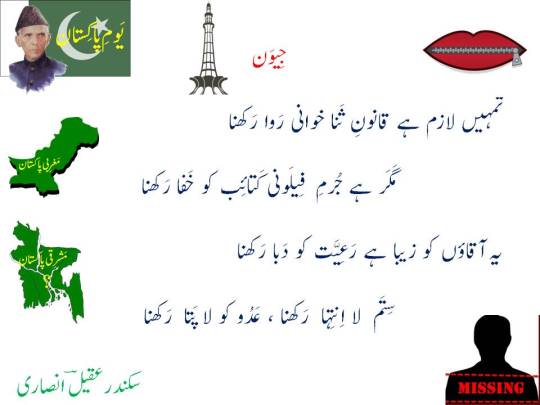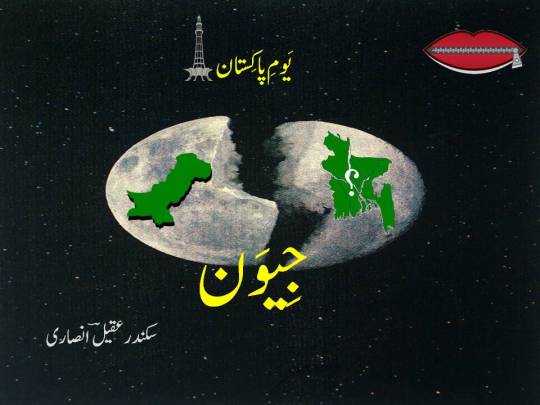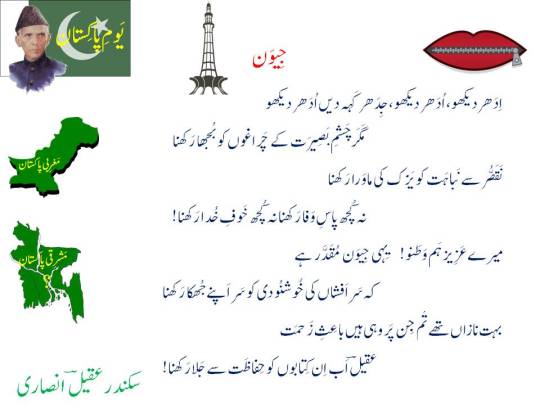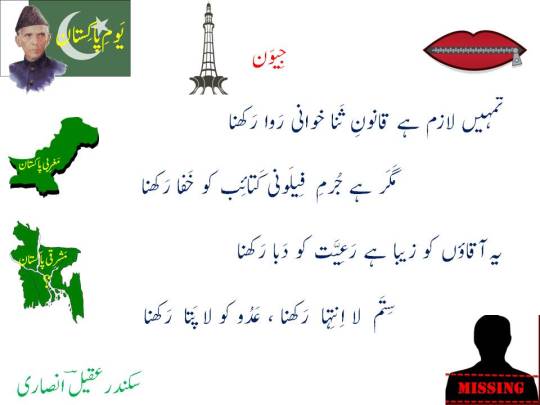#پاکِستان
Photo

Happy Pakistan Day!
#Pakistan#پاکِستان#Urdu#Islamabad#Karachi#اسلام آباد#کراچی#map#hoodie#sportswear#activewear#fitness#green#dark green#sweatshirt
3 notes
·
View notes
Text
پنجاب کے 11 ڈرگ انسپکٹرز کو بلاجواز معطل کرنے پر فارماسسٹس ایسوسی ایشن نے احتجاج کی دھمکی دے دی
پریزیڈنٹ پاکِستان فارماسِسٹس ایسوسی ایشن پنجاب، پروفیسر ڈاکٹر فرقان ہاشمی کی زیر صدارت لاہور میں ہنگامی اجلاس ہوا، جس میں پاکِستان فارماسِسٹس ایسوسی ایشن پنجاب کابینہ کے تمام عہدیداران بشمول جنرل سیکرٹری ڈاکٹرآصف فاروق اعوان، ڈاکٹر عمیر اِکرام ڈار، عبدالمجید بھٹی ایڈووکیٹ، ڈاکٹر شبیر احمد، پروفیسر ڈاکٹر مہتاب ، ڈاکٹر کلیم اللہ، ڈاکٹر سلیم منصور، ڈاکٹر فاروق احمد، ڈاکٹر جہانزیب وٹوُ ، ڈاکٹر…

View On WordPress
0 notes
Note
are your parents/grandparents from Pakistan?
We have a three-quarter winner! (3 out of 4 were from پاکِستان)
What gave it away? My affinity for British royal family gossip? Calling Mohamed Al-Fayed an assclown?
9 notes
·
View notes
Video
Pakistan Day Urdu poetry video 'jeevan'-15 - یَومِ پاکِستان ۔ جِیوَن
#23 march#pakistan day#lahore resolution#pakistan resolution#Quaid-i-Azam#east pakistan#Fascism#military dictatorship#press censorship
2 notes
·
View notes
Text
Abdul Qadeer Khan
Abdul Qadeer Khan ڈاکٹر عبد القدیر خان; b. 1 April 1936); DEngr, NI (twice), HI, FPAS; also respectfully known by some in Pakistan as Mohsin-e-Pakistan (in Urdu: محسن پاکِستان; lit: Savior of Pakistan), more popularly known as Dr. A. Q. Khan, is a Pakistani nuclear scientist and a metallurgical engineer, colloquially regarded as the founder of HEU based Gas-centrifuge uranium enrichment program for Pakistan's integrated atomic bomb project.[2] Founded and established the Kahuta Research Laboratories (KRL) in 1976, he was both its senior scientist and the director-general until his retirement in 2001, and was an early and vital figure in other science projects. Apart from participating in atomic bomb project, he made major contributions in molecular morphology, physical martensite, and its integrated applications in condensed and material physics.
Abdul Qadeer Khan was one of Pakistan's top scientists,[3] and was involved in the country's various scientific programs until his dismissal.[3] In January 2004, Khan was officially summoned for a debriefing on his suspicious activities in other countries after the United States provided evidence to the Pakistan Government, and confessed it a month later.[3] Some have alleged that these activities were sanctioned by the authorities, though the Pakistan government sharply dismissed the claims.[4][5] After years of nominal house arrest, the Islamabad High Court (IHC) on 6 February 2009 declared Abdul Qadeer Khan to be a free citizen of Pakistan, allowing him free movement inside the country. The verdict was rendered by Chief Justice Sardar Muhammad Aslam.[6] In September 2009, expressing concerns over the Islamabad High Court's decision to end all security restrictions on Khan, the United States warned that Khan still remains a "serious proliferation risk".[7]
Early life
Khan was born in Bhopal, India (then British Indian Empire) into a Urdu-speaking family in 1936. His father Dr. Abdul Ghafoor Khan was an academic who served in the Education ministry of the British Indian Government and after retirement in 1935, settled permanently in Bhopal State.[8] After the partition in 1947, the family emigrated from India to Pakistan, and settled in West-Pakistan.[9] Khan studied in Saint Anthony's High School of Lahore, and then enrolled at the D.J. Science College of Karachi to study physics and mathematics.[9] After making a transfer in 1956, he attended Karachi University, obtaining BSc in Metallurgy in 1960; subsequently he got the internship at the Siemens Engineering.[9]
After the internship, he was employed by the Karachi Metropolitan Corporation and worked as an city inspector of weight and measures in Karachi.[9] In 1961, he went to West Berlin to study Metallurgical engineering at the Technical University Berlin.[9] Qadeer Khan obtained an engineer's degree in technology from Delft University of Technology in the Netherlands, and a doctorate engineering in Metallurgical engineering under the supervision of Martin Brabers from the Catholic University of Leuven in Belgium, in 1972.[9] Qadeer Khan's doctoral dissertations were written in German.[9] His doctoral thesis dealt and contained fundamental work on martensite, and its extended industrial applications to the field of Morphology, a field that studies the shape, size, texture and phase distribution of physical objects.[9][10]
Research in Europe
Main articles: Nuclear power in the Netherlands and Netherlands and weapons of mass destruction
In 1972, the year he received his doctorate, Abdul Qadeer Khan through a former university classmate, and a recommendation from his old professor and mentor, Martin J. Brabers, joined the senior staff of the Physics Dynamics Research Laboratory in Amsterdam.[11] There, he began his studies on the high-strength metals to be used for the development of gas centrifuges.[12] The gas centrifuges were first studied by Jesse Beams during the Manhattan Project in 1940s but research was discontinued in 1944. The Physics Laboratory was a subcontractor for URENCO Group, the uranium enrichment research facility at Almelo, Netherlands, which was established in 1970 by the Netherlands to assure a supply of enriched uranium for nuclear power plants in the Netherlands.[11] Soon when the URENCO Group offered him to join the senior scientific staff there, Qadeer Khan left the Physics Laboratories.[11] There, he was tasked to perform physics experiments on uranium metallurgy,[11] to produce commercial-grade uranium metals usable for light water reactors.[11]
In the meantime, the URENCO Group handed him the drawings of centrifuges for the mathematical solution of the physics problems in the gas centrifuges.[11] Uranium enrichment is a difficult physical process, as 235U exists in natural uranium at a concentration of only 0.7%; URENCO used Zippe-type centrifuges for that purpose to separate the isotopes 235U from non-fissile 238U by spinning UF6 gas at up to 100,000RPM.[11] Abdul Qadeer Khan's academic and leading-edge research in metallurgy brought laurels to the URENCO Group.[11]
URENCO enjoyed a good academic relationship with him, and had him as one of its most senior scientists at the facility where he researched and studied.[11] At URENCO, Abdul Qadeer Khan pioneering research to improve the efficiency of the centrifuges greatly contributed to the technological advancement of the Zippe centrifuges, a method that was developed by mechanical engineer Gernot Zippe in the Soviet Union during the 1940s.[11] URENCO granted Qadeer Khan access to the most restricted areas of its facility as well as to highly classified documentation on gas centrifuge technology.[11]
1971 war and return to Pakistan
Main articles: Operation Smiling Buddha, Project-706, and Zulfikar Ali Bhutto#Father of the Nuclear weapons program
The clandestine and highly secretive atomic bomb project of Pakistan was given a start on 20 January 1972, when President (later Prime minister) Zulfikar Ali Bhutto chaired a secret meeting of academic scientists at Multan.[13] The winter planning seminar known as Multan meeting, the atomic bomb project was launched under the administrative control of Bhutto, and the Pakistan Atomic Energy Commission (or PAEC) under its chairman, Munir Ahmad Khan.[13] Earlier efforts were directed towards the implosion-type bomb with exploration of the Plutonium route.[13] Prior to 1974, Khan had no knowledge of existence of country's integrated atomic development, a controversy that highly doubts Abdul Qadeer Khan's "father-of" claim.
It was only on 18 May 1974, when he was alerted after India surprised the world with its first nuclear test (codename: Smiling Buddha), near Pakistan's eastern border under the secret directives of Indian Premier Indira Gandhi.[13] Conducted by the Indian Army, it was only three years since Pakistan's humiliating defeat in the 1971 Winter war and the outcomes of the war had put Pakistan's strategic position in great danger.[14] The nuclear test greatly alarmed the Government of Pakistan and the people.[13] Prime minister Zulfikar Bhutto squeezed the time limit of the atomic bomb project from five years to three years, in a vision to evolve and derived the country's scientific atomic project as from the "atomic capability to sustainable nuclear power".[13] Sensing the importance of this test, Munir Ahmad Khan secretly launched the Project-706, a codename of a secret uranium enrichment program under the domain of the atomic project.[13]
Following the news about Pakistan, Khan wanted to contribute to the post-war military posture and approached the Pakistan government officials, offering to assist in Pakistan's secret atomic bomb project through his knowledge acquired at URENCO.[15] He insisted in joining the atomic bomb project[16] but was disuated by the military scientists who considered as "hard to find" a job in PAEC as a "metallurgist".[15]
Undaunted, he wrote to Prime minister Zulfikar Ali Bhutto, highlighting his specific experience and encouraged Prime Minister Bhutto to work on an atomic bomb using uranium.[15] According to Kuldip Nayyar, although the letter was received by Prime minister Secretariat, Qadeer Khan was still unknown to the Government, leading Bhutto to ask the ISI to run a complete background check on Khan and prepare an assessment report on him.[17] The ISI declared him as "incompetent" in the field of nuclear technology based on his academic discipline.[17] Unsatisfied with ISI's report, Bhutto was eager to know more about him, and asked Munir Ahmad Khan to dispatch a team of PAEC's scientists to meet him.[18] The PAEC team including Sultan Mahmood travelled to Amsterdam and arrived at his family home at night. Discussions were held until the next day.[18] After the team's return to Pakistan, Bhutto decided to meet with Khan, and directed a confidential letter to him. Soon after, Abdul Qadeer Khan took a leave from URENCO Group, and departed for Pakistan in 1974.[18]
Initiation and atomic bomb project
Main article: Project-706
In December 1974, Abdul Qadeer Khan went to Pakistan and took a taxi straight to the Prime minister Secretariat.[19] The session with Bhutto was held at midnight and remained under extreme secrecy.[19] There, Qadeer Khan met with Zulfikar Bhutto, Munir Khan, and Dr. Mübaschir Hassan, government Science Adviser.[19] At this session, he enlightened the importance of uranium as opposed to plutonium, but Bhutto remain unconvinced to adopt uranium instead of plutonium for the development of an atomic bomb.[19] Although Bhutto ended the session quickly he remarked to his friends that: "He seems to make sense."[19]
Early morning the next day another session was held where he focussed the discussion on uranium against plutonium, with other PAEC officials presented.[16] Even though he explained to Bhutto why he thought the idea of "plutonium" would not work, Qadeer Khan was fascinated by the possibility of atomic bomb.[16] Many of the theorists at that time, including Munir Khan maintained that "plutonium and the nuclear fuel cycle has its significance",[14] and Munir Khan insisted that with the "French extraction plant in the offing, Pakistan should stick with its original plan."[14] Bhutto did not disagree, but saw the advantage of mounting a parallel effort toward acquiring HEU fuel.[14][20] At the last session with Zulfikar Bhutto, Khan also advocated for the development of a fused design to compress the single fission element in the metalized gun-type atomic device, which many of his fellow theorists said would be unlikely to work.[16][21]
Finally in 1976, he joined the atomic bomb project, and became a member of the enrichment division at PAEC.[19] Calculations performed by him were valuable contributions to centrifuges and vital link to nuclear weapon research.[13] He continued to push his ideas for uranium methods even though they had a low priority, with most efforts still aimed to produce military-grade plutonium.[19] Because of his interest in uranium, and his frustration at having been passed over for director of the uranium division (the job was instead given to Bashiruddin Mahmood), Qadeer Khan refused to engage in further research and caused tensions with other researchers.[19] He became highly unsatisfied and bored with the research led by Mahmood; finally, he submitted a critical report to Bhutto, in which he explained that the "enrichment program" was nowhere near success.[19]
Kahuta Research Laboratories
Main articles: Engineering Research Laboratories and Kahuta Test
Bhutto sensed great danger as the scientists were split between uranium and plutonium routes.[19] Therefore, he called Khan for a meeting, which was held at the prime minister secretariat. With the backing of Bhutto, Qadeer Khan took over the enrichment program and renamed the project to Engineering Research Laboratories (ERL).[19] Abdul Qadeer Khan insisted to work with the Corps of Engineers to lead the construction of the suitable operational enrichment site, which was granted. The E-in-C directed Brigadier Zahid Ali Akbar of Corps of Engineers to work with Qadeer Khan in Project-706.[19] The Corps of Engineers and Brigadier Akbar quickly acquired the lands of the village of Kahuta for the project.[22]
The military realized the dangers of atomic experiments being performed in populated areas and thus remote Kahuta was considered an ideal location for reearch.[22] Bhutto would subsequently promote Brigadier Zahid Akbar to Major-General and handed over the directorship of the Project-706, with Qadeer Khan being its senior scientist.[23]
On the other hand, the PAEC did not forgo the electromagnetic isotope separation research and a parallel program was conducted by theoretical physicist Dr. G.D. Allam at Air Research Laboratories (ARL) located at Chaklala PAF base, though G.D. Allam had not seen a centrifuge, but only had a rudimentary knowledge of the Manhattan Project.[24]
At first, the ERL suffered many setbacks, and relied heavily on the knowledge from URENCO brought by Qadeer Khan.[24] Meanwhile in April 1976, theorist Ghulam Dastigar Alam accomplished a great feat by successfully rotating the first generation centrifuges to ~30,000 RPM.[24] When the news reached Qadeer Khan, he immediately requested to Bhutto for G.D. Alam's assistance which was granted by the PAEC, dispatching a team of scientists including G.D. Alam to ERL.[24] At ERL, Qadeer Khan joined the team of theoretical physicists headed by theorist dr. GD Allam, working on the physics problems involving the differential equations in the centripetal forces and angular momentum calculations in the ultra-centrifuges.[24] On 4 June 1978, the enrichment program became fully functional after Dr. G.D. Alam succeeded in separated the 235U and 238U isotopes in an important experiment in which Dr. A.Q Khan also took part.[24][25] Contrary to his expectation, the military approved to the appointment of Major-General Zahid Ali as the scientific director of entire uranium division
Legacy
During his time in the atomic bomb project, he pioneered research in the thermal quantum field and the condensed physics, while co-authored articles on chemical reactions of the highly unstable isotopic particles in the controlled physical system.[55] He maintains his stance to use of controversial technological solutions to both military and civilian problems, including the use of military technologies for the civilian welfare. Khan also remained a vigorous advocate for a nuclear testing program and defence strength through nuclear weapons. He has justified the Pakistan's nuclear deterrence program as sparing his country the fate of Iraq or Libya.[56] In his recent interview, Abdul Qadeer Khan maintained that he has no regrets for what he did and maintained that:
[P]akistan's motivation for nuclear weapons arose from a need to prevent "nuclear blackmail" by India. Had Iraq and Libya been nuclear powers, they wouldn't have been destroyed in the way we have seen recently.... If (Pakistan) had an [atomic] capability before 1971, we [Pakistanis] would not have lost half of our country after a disgraceful defeat.
—Abdul Qadeer Khan, statement on 16 May 2011, published the Newsweek, [57]
Abdul Qadeer Khan faced heated and intense criticism from his fellow theorists whom he had worked with in the atomic bomb project, most notably theorist Dr. Pervez Hoodbhoy.[58] In addition, Qadeer Khan's false claims that he was the "father" of the atomic bomb project since its inception and his personal attacks on Munir Khan caused even greater animosity by his fellow theorists, and most particularly, within the general physics community towards Qadeer Khan.[2][58] Due to public promotion by the Pakistan media, he remains one of the best known but also most controversial scientists in the country.[3] He has been depicted in the media as Pakistan's own Dr. Strangelove (commonly referred to Edward Teller) in Stanley Kubrick's 1964 satirical film of the same name.[59]
He is the recipient of the following honors:
Nishan-e-Imtiaz (1999)
Nishan-e-Imtiaz (1996)
Hilal-e-Imtiaz (1989)
Sir Syed University of Engineering and Technology[53]
60 Gold medal from universities in the country.[53]
University of Karachi[53]
Baqai Medical University[60]
Hamdard University[53]
Gomal University[53]
University of Engineering and Technology, Lahore[53]
Publications
Selected research papers and patents
Nuclear and Material physics
Dilation investigation of metallic phase transformation in 18% Ni maraging steels, Proceedings of The International Conf. on Martensitie Transformations (1986), The Japan Institute of Metals, pp. 560–565.
The spread of Nuclear weapons among nations: Militarization or Development, pp. 417–430. (Ref. Nuclear War Nuclear Proliferation and their consequences "Proceedings of the 5th International Colloquium organized by the Group De Bellerive Geneva 27–29 June 1985, Edited by: Sadruddin Aga Khan, Published by Clarendon Press-Oxford 1986).
Flow induced vibrations in Gas-tube assembly of centrifuges. Journal of Nuclear Science and Technology, 23(9), (September 1986), pp. 819–827.
Dimensional anisotropy in 18% of maraging steel,[61] Seven National Symposium on Frontiers in Physics, written with Anwar-ul-Haq, Mohammad Farooq, S. Qaisar, published at the Pakistan Physics Society (1998).
Thermodynamics of Non-equilibrium phases in Electron-beam rapid solidification,[55] Proceedings of the Second National Symposium on Frontiers in Physics, written with A. Tauqeer, Fakhar Hashmi, publisher Pakistan Physics Society (1988).
Books
Khan, Abdul Qadeer (1972). Advances in Physical Metallurgy (in English, German and Dutch). Amsterdam, Netherlands: Elsevier Press. ISBN 969-8500-00-6.
Khan, Abdul Qadeer (1983). Metallurgical Thermodynamics and Kinetics (in English, German and Dutch). Islamabad, Pakistan: The Proceedings of the Pakistan Academy of Sciences. ISBN 978-969-35-0821-5.
Khan, Abdul Qadeer; Syed Shabbir Hussain, Mujahid Kamran (1997). Dr. A.Q. Khan on science and education. Islamabad, Pakistan: Sang-e-Meel Publications. ISBN 978-969-35-0821-5..[24]
#United States#Sardar Muhammad Aslam#Pakistan#Khan#Islamabad High Court#British Raj#Bhopal#Abdul Qadeer Khan
1 note
·
View note
Link
Liked on YouTube: Green Pakistan https://youtu.be/px-v2MZmLbY Pakistan[b] (Urdu: پاکِستان), officially the Islamic Republic of Pakistan (Urdu: اِسلامی جمہوریہ پاکِستان), is a country in South Asia. It is the sixth-most populous country with a population exceeding 212,742,631 people.[19] In area, it is the 33rd-largest country, spanning 881,913 square kilometres (340,509 square miles). Pakistan has a 1,046-kilometre (650-mile) coastline along the Arabian Sea and Gulf of Oman in the south and is bordered by India to the east, Afghanistan to the west, Iran to the southwest, and China in the far northeast. It is separated narrowly from Tajikistan by Afghanistan's Wakhan Corridor in the northwest, and also shares a maritime border with Oman. The territory that now constitutes Pakistan was the site of several ancient cultures and intertwined with the history of the broader Indian subcontinent. The ancient history involves the Neolithic site of Mehrgarh and the Bronze Age Indus Valley Civilisation, and was later home to kingdoms ruled by people of different faiths and cultures, including Hindus, Indo-Greeks, Muslims, Turco-Mongols, Afghans and Sikhs. The area has been ruled by numerous empires and dynasties, including the Persian Achaemenid Empire, Alexander III of Macedon, the Seleucid Empire, the Indian Maurya Empire, the Gupta Empire,[26] the Arab Umayyad Caliphate, the Delhi Sultanate, the Mongol Empire, the Mughal Empire, the Afghan Durrani Empire, the Sikh Empire (partially) and, most recently, the British Empire.[27][28] Pakistan is the only country to have been created in the name of Islam.[29][30] It is an ethnically and linguistically diverse country, with a similarly diverse geography and wildlife. Initially a dominion, Pakistan adopted a constitution in 1956, becoming an Islamic republic. An ethnic civil war in 1971 resulted in the secession of East Pakistan as the new country of Bangladesh.[31] In 1973 Pakistan adopted a new constitution which stipulated that all laws are to conform to the injunctions of Islam as laid down in the Quran and Sunnah.[32] A regional[33][34][35] and middle power,[36][37][38] Pakistan has the sixth-largest standing armed forces in the world and is also a nuclear power as well as a declared nuclear-weapons state, the second in South Asia and the only nation in the Muslim world to have that status. Pakistan has a semi-industrialised economy with a well-integrated agriculture sector and a growing services sector.[39][40] It is ranked among the emerging and growth-leading economies of the world,[41][42] and is backed by one of the world's largest and fastest-growing middle class.[43][44] Pakistan's political history since independence has been characterized by periods of military rule, political instability and conflicts with India. The country continues to face challenging problems, including overpopulation, terrorism, poverty, illiteracy, and corruption.[45][46][47][48] Pakistan is a member of the UN, the Shanghai Cooperation Organisation, the OIC, the Commonwealth of Nations, the SAARC and the Islamic Military Counter Terrorism Coalition.
0 notes
Photo

August 14: Today's Specialities & Photo: Amazing Birds. Christian feast day: Domingo Ibáñez de Erquicia Eusebius of Rome Jonathan Myrick Daniels (Episcopal Church) Kaj Munk (with Kolbe, Lutheran Church) Martyrs of Otranto Maximilian Kolbe August 14 (Eastern Orthodox liturgics) Anniversary Day (Tristan da Cunha) Commemoration of Wadi al-Dahab or Zikra Oued Ed-Dahab (Morocco) Engineer's Day (Dominican Republic) Day of the Defenders of the Fatherland (Abkhazia) (state is not fully recognized) Independence Day, celebrates the day when Pakistan was declared a sovereign nation following the end of the British Raj in 1947. Pramuka Day (Indonesia) Falklands Day #Christian #DomingoIbáñezdeErquicia #EusebiusofRome #JonathanMyrickDaniels #EpiscopalChurch #KajMunk #Kolbe #LutheranChurch #MartyrsofOtranto #MaximilianKolbe #August14 #AnniversaryDay #TristandaCunha #CommemorationofWadialDahab #ZikraOuedEdDahab #Morocco #EngineersDay #DominicanRepublic #DayoftheDefendersoftheFatherland #Abkhazia #IndependenceDay #Pakistan #یومآزادی #پاکِستان) #PramukaDay #GerakanPramuka #Indonesia #Indonesian #FalklandsDay #Peacock
0 notes
Text
Tweeted
لدي 3 متابعين جدد من پاکِستان, وبلدان أخرى خلال الأسبوع الماضي https://t.co/j8ICafKUUd http://pic.twitter.com/3TkjC872Sz
— عبد الفتاح كيرة (@AbdoKera) November 24, 2017
0 notes
Photo










23 March Pakistan Day Urdu poetry 'jeevan' - یَومِ پاکِستان ۔ جِیوَن
#urdu poetry#23 march#pakistan day#lahore resolution#pakistan resolution#Quaid-i-Azam#east pakistan#Fascism#freedom of speech#oppression#dictatorship#press censorship
0 notes
Photo

Pakistan Day Urdu poetry 'jeevan'-1 - یَومِ پاکِستان ۔ جِیوَن
0 notes
Photo

Pakistan Day Urdu poetry 'jeevan'-2 - یَومِ پاکِستان ۔ جِیوَن
0 notes
Photo

Pakistan Day Urdu poetry 'jeevan'-3 - یَومِ پاکِستان ۔ جِیوَن
0 notes
Photo

Pakistan Day Urdu poetry 'jeevan'-4 - یَومِ پاکِستان ۔ جِیوَن
0 notes